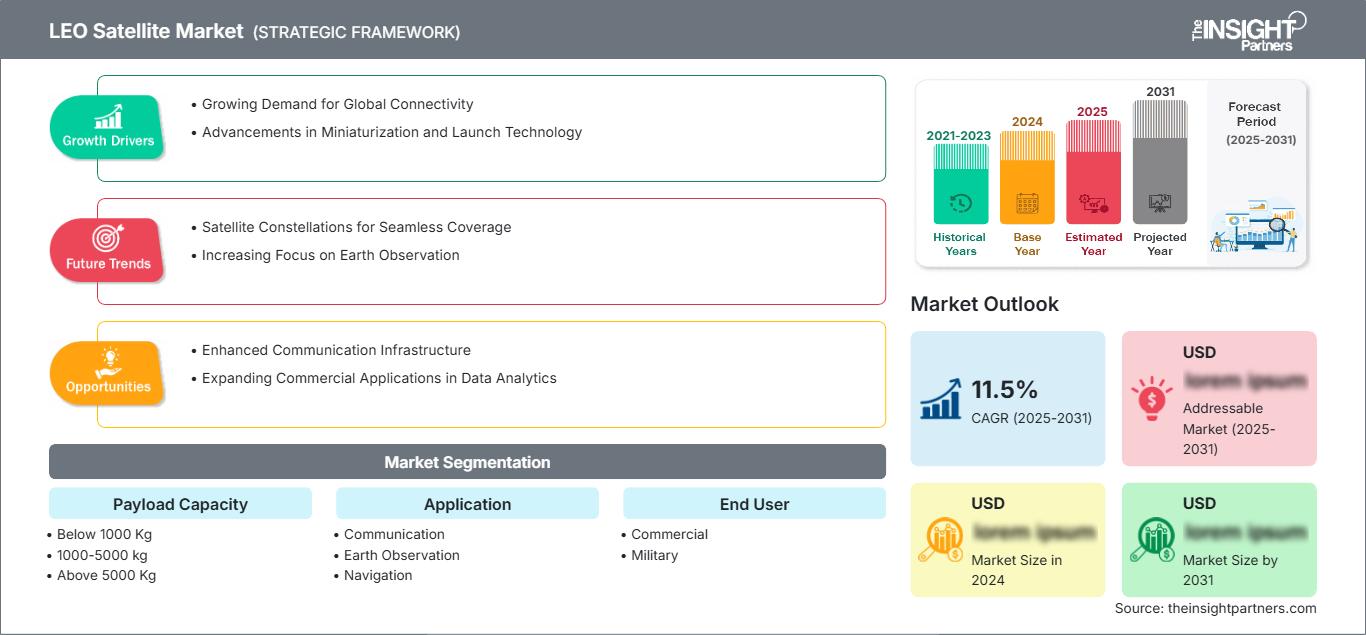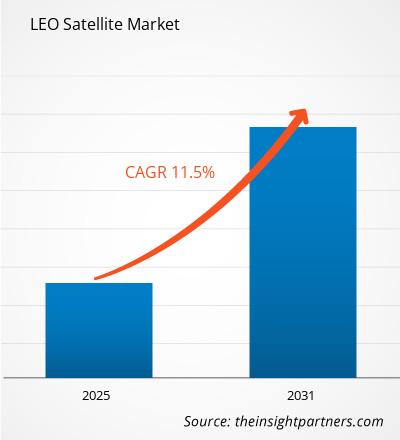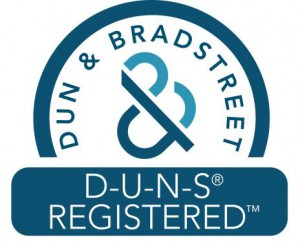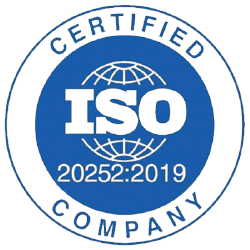The LEO Satellite Market is expected to register a CAGR of 11.5% from 2025 to 2031, with a market size expanding from US$ XX million in 2024 to US$ XX Million by 2031.
The report is segmented by Payload Capacity (Below 1000 Kg, 1000-5000 kg, Above 5000 Kg); Application (Communication, Earth Observation, Navigation, Space Science, Others); End User (Commercial, Military). The global analysis is further broken-down at regional level and major countries. The Report Offers the Value in USD for the above analysis and segments.
Purpose of the Report
The report LEO Satellite Market by The Insight Partners aims to describe the present landscape and future growth, top driving factors, challenges, and opportunities. This will provide insights to various business stakeholders, such as:
- Technology Providers/Manufacturers: To understand the evolving market dynamics and know the potential growth opportunities, enabling them to make informed strategic decisions.
- Investors: To conduct a comprehensive trend analysis regarding the market growth rate, market financial projections, and opportunities that exist across the value chain.
- Regulatory bodies: To regulate policies and police activities in the market with the aim of minimizing abuse, preserving investor trust and confidence, and upholding the integrity and stability of the market.
LEO Satellite Market Segmentation
Payload Capacity
- Below 1000 Kg
- 1000-5000 kg
- Above 5000 Kg
Application
- Communication
- Earth Observation
- Navigation
- Space Science
- Others
End User
- Commercial
- Military
Geography
- North America
- Europe
- Asia-Pacific
- South and Central America
- Middle East and Africa
You will get customization on any report - free of charge - including parts of this report, or country-level analysis, Excel Data pack, as well as avail great offers and discounts for start-ups & universities
LEO Satellite Market: Strategic Insights

- Get Top Key Market Trends of this report.This FREE sample will include data analysis, ranging from market trends to estimates and forecasts.
LEO Satellite Market Growth Drivers
- Growing Demand for Global Connectivity: The increasing need for ubiquitous, high-speed internet access, particularly in remote and underserved regions, is a key driver for the LEO satellite market. LEO satellites, with their low latency and ability to provide global coverage, are ideal for delivering broadband services to rural areas, maritime, and aviation sectors. Major players like SpaceX’s Starlink and Amazon’s Kuiper Systems are leading the push to provide reliable and affordable internet worldwide, accelerating LEO satellite adoption.
- Advancements in Miniaturization and Launch Technology: Technological advancements in satellite miniaturization and low-cost, reusable launch vehicles are significantly lowering the cost of deploying LEO satellites. Smaller, lighter satellites can now be launched in constellations, driving economies of scale and making large satellite networks more feasible. This innovation is reducing entry barriers and enabling both private and governmental organizations to deploy more satellites at lower costs.
LEO Satellite Market Future Trends
- Satellite Constellations for Seamless Coverage: The trend toward deploying large satellite constellations is revolutionizing the LEO satellite market. Companies like SpaceX, OneWeb, and Amazon are planning to deploy thousands of small satellites to ensure seamless, global coverage with high-speed internet. This trend will likely dominate the market in the coming years, with a focus on providing low-latency services and bridging the digital divide.
- Increasing Focus on Earth Observation: LEO satellites are playing a growing role in Earth observation, providing real-time data for agriculture, disaster management, environmental monitoring, and military reconnaissance. With the development of high-resolution imaging technologies and AI-powered analytics, LEO satellites are becoming critical for monitoring changes in land use, weather patterns, and climate change, creating more opportunities for data-driven decision-making across industries.
LEO Satellite Market Opportunities
- Enhanced Communication Infrastructure: The rapid growth of 5G and IoT networks presents a significant opportunity for LEO satellites to support next-generation communication systems. LEO satellites are particularly well-suited for backhaul services, extending 5G networks to rural and remote areas, improving global connectivity, and enabling faster, more reliable communication for businesses, governments, and consumers alike.
- Expanding Commercial Applications in Data Analytics: As LEO satellites increasingly capture vast amounts of data, there is a growing opportunity to monetize this data through advanced analytics. Companies can offer services related to climate monitoring, traffic management, agricultural optimization, and environmental forecasting. The growing use of AI and machine learning will enable enhanced data processing capabilities, unlocking valuable insights for various industries, from insurance to transportation.
LEO Satellite Market Regional Insights
The regional trends and factors influencing the LEO Satellite Market throughout the forecast period have been thoroughly explained by the analysts at The Insight Partners. This section also discusses LEO Satellite Market segments and geography across North America, Europe, Asia Pacific, Middle East and Africa, and South and Central America.
LEO Satellite Market Report Scope
| Report Attribute | Details |
|---|---|
| Market size in 2024 | US$ XX million |
| Market Size by 2031 | US$ XX Million |
| Global CAGR (2025 - 2031) | 11.5% |
| Historical Data | 2021-2023 |
| Forecast period | 2025-2031 |
| Segments Covered |
By Payload Capacity
|
| Regions and Countries Covered | North America
|
| Market leaders and key company profiles |
|
LEO Satellite Market Players Density: Understanding Its Impact on Business Dynamics
The LEO Satellite Market is growing rapidly, driven by increasing end-user demand due to factors such as evolving consumer preferences, technological advancements, and greater awareness of the product's benefits. As demand rises, businesses are expanding their offerings, innovating to meet consumer needs, and capitalizing on emerging trends, which further fuels market growth.

- Get the LEO Satellite Market top key players overview
Key Selling Points
- Comprehensive Coverage: The report comprehensively covers the analysis of products, services, types, and end users of the LEO Satellite Market, providing a holistic landscape.
- Expert Analysis: The report is compiled based on the in-depth understanding of industry experts and analysts.
- Up-to-date Information: The report assures business relevance due to its coverage of recent information and data trends.
- Customization Options: This report can be customized to cater to specific client requirements and suit the business strategies aptly.
The research report on the LEO Satellite Market can, therefore, help spearhead the trail of decoding and understanding the industry scenario and growth prospects. Although there can be a few valid concerns, the overall benefits of this report tend to outweigh the disadvantages.
Frequently Asked Questions
What are the options available for the customization of this report?
What are the deliverable formats of the LEO satellite market report?
What are the driving factors impacting the LEO satellite market?
1. Demand for Commercial Satellite Communication
2. Demand from Satellite-Based Military Communications
What are the future trends of the LEO satellite market?
1. Rising Number of LEO Satelite Constellations
2. Deployment of Nano and Picosatellites
What is the expected CAGR of the LEO Satellite Market?
- Historical Analysis (2 Years), Base Year, Forecast (7 Years) with CAGR
- PEST and SWOT Analysis
- Market Size Value / Volume - Global, Regional, Country
- Industry and Competitive Landscape
- Excel Dataset
Recent Reports
Testimonials
Reason to Buy
- Informed Decision-Making
- Understanding Market Dynamics
- Competitive Analysis
- Identifying Emerging Markets
- Customer Insights
- Market Forecasts
- Risk Mitigation
- Boosting Operational Efficiency
- Strategic Planning
- Investment Justification
- Tracking Industry Innovations
- Aligning with Regulatory Trends





















 Get Free Sample For
Get Free Sample For